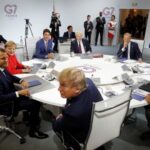Civil unrest flared and curfews were imposed in several major US cities on Saturday as demonstrators took to the streets to vent outrage at the death of a black man shown on video gasping for breath as a white Minneapolis policeman knelt on his neck.
From Los Angeles to Miami to Chicago, protests marked by chants of “I can’t breathe” – a rallying cry echoing the dying words of George Floyd – began peacefully before turning unruly as demonstrators blocked traffic, set fires and clashed with riot police, some firing tear gas and plastic bullets in an effort to restore order.
The sight of protesters flooding streets fueled a sense of crisis in the United States after weeks of lockdowns due to the coronavirus pandemic, which has seen millions thrown out of work and has disproportionately affected minority communities.
In the nation’s capital, hundreds of demonstrators assembled near the Justice Department headquarters shouting, “black lives matter.” Many later moved to the White House, where they faced off with shield-carrying police, some mounted on horseback.
US President Donald Trump said on Saturday that if protesters who gathered the night before in
Lafayette Square, across from the White House, had breached the fence, “they would have been greeted with the most vicious dogs, and most ominous weapons, I have ever seen.”
The full Minnesota National Guard was activated for the first time since World War II after four nights of arson, looting and vandalism in parts of Minneapolis, the state’s largest city, and its adjacent capital, St. Paul.
Minnesota Governor Tim Walz said the deployment was necessary because outside agitators were using protests over Floyd’s death to sow chaos, and that he expected Saturday night’s demonstrations to be the fiercest so far.
“We are under assault,” Walz, a first-term governor elected from Minnesota’s Democratic-Farmer-Labor Party, told a briefing on Saturday. “Order needs to be restored.”
Separately, US Attorney General William Barr also pointed the finger at extremist instigators, though he and Walz – neither offering evidence to support their assertions – suggested opposite ends of the political fringe were to blame.
National discontent reflected
Civil rights activists said video of Floyd’s arrest on May 25 – captured by an onlooker’s cellphone as he repeatedly groaned, “please, I can’t breathe” before he died – triggered an outpouring of rage that has long simmered in Minneapolis and cities across the country over persistent racial bias in the US criminal justice system. But the rapidly spreading protests – peaceful and lawless alike – also coincided with a deep-seated mood of national discontent over the social claustrophobia and economic carnage wrought by the coronavirus pandemic.
In a surreal moment for Miami on Saturday, police sirens and lights flooded downtown neighborhoods as fireworks began crackling and booming over Biscayne Bay to honor healthcare workers fighting the ongoing pandemic. Hundreds of police in riot gear swarmed the area, threatening to arrest anyone, including media, who ventured onto the streets.
Curfews were imposed in several major cities rocked by civil disturbances in recent days.
In an extraordinary move, the Pentagon said it put military units on a four-hour alert to be ready if requested by the Minnesota governor to help keep the peace.
National Guard units also were mobilized by the governors of Ohio, Missouri, Wisconsin and Tennessee.
The streets of Minneapolis were largely quiet during the day on Saturday, as several armored National Guard vehicles were seen rolling through town. But authorities later closed major highways leading in and out of Minneapolis-St. Paul.
At dusk, about a half hour after curfew, a line of police moved into an area occupied by about 500 protesters near a burned-out bank and opened fire with tear gas, pepper spray and plastic bullets, sending the crowd scurrying.
It marked the fifth night of such clashes, the second since Friday’s announcement that Derek Chauvin, the policeman seen kneeling on Floyd’s neck, had been arrested on murder charges in Floyd’s death.
Floyd, who had worked security for Minneapolis nightclubs, had been suspected of trying to pass counterfeit money to buy cigarettes on the evening of May 25. Police said he was unarmed. A store employee who had called for help had told a police dispatcher that the suspect appeared to be intoxicated.
Three other officers dismissed on Tuesday from the police department with Chauvin, who was known to have worked off-duty security at one of the same nightclubs as Floyd, are also under criminal investigation in the case, prosecutors said.
‘Could’ve killed them’
Anger stoked by Floyd’s death was widespread.
Thousands flooded Chicago streets for a second day of protests. Cellphone footage shared with Reuters showed an overturned SUV, a patrol car on fire, a person burning the American flag and a skirmish between demonstrators and police.
In the Brooklyn borough of New York City, a police squad car drove into a crowd of protesters during a second day of violence after more than 200 arrests were made on Friday.
“They could’ve killed them, & we don’t know how many they injured,” US Representative Alexandria Ocasio-Cortez wrote on Twitter, demanding that the NYPD officers be brought to justice.
At a late-night news conference, New York Mayor Bill de Blasio suggested protesters were to blame.
“The video was upsetting, and I wish the officers hadn’t done that,” De Blasio said.
Demonstrators confront police officers outside the White House on Saturday in Washington DC during a protest over the death of George Floyd, an unarmed black man, who died after a Minneapolis police officer kneeled on his neck for several minutes. Photo: AFP



